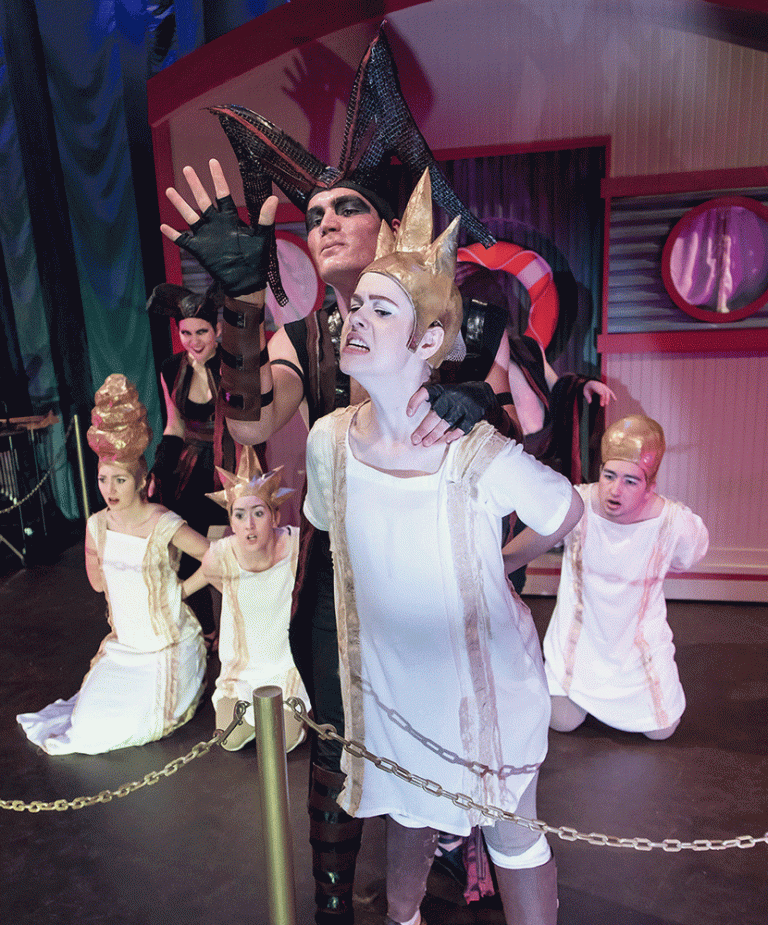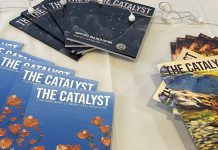
Arturo Samaniego
Staff Writer
“Mr. Burns: A Post-Electric Play” takes an intriguing look at how stories evolve through time, and the significant role they play in our society especially during times of crises. The play achieves this through being an unofficial off-shoot of “The Simpsons,” centering the plot around the recounting of a “Simpsons” episode that over time morphs into a familiar but new work.
The play opened Saturday to a crowded room at Hatlen Theater, using elaborate props, clever storytelling, entertaining musical numbers, and stellar acting to present its rather dark subject matter in a somewhat humorous and optimistic light.
The play opens up in what appears to be the aftermath of a nuclear catastrophe, destroying the power grid and leaving people scattered and confused. The cleverness of the storytelling is immediately apparent as the dialogue never goes off into unnecessary exposition, but rather gives the audience enough information to fill in gaps in the story. This is true for all three acts of the play which open in the middle of the action and can be a bit jarring, but does not take long to figure what exactly is going on.
The most entertaining parts of the play come when dealing with the main theme: storytelling, how stories evolve overtime, and its significance during times of crises. This theme is on full display right at the onset of the play as a group of survivors gather around a campfire recounting an episode of “The Simpsons.”
Here we see how storytelling can serve as a source of comfort during traumatic times as one character quickly shifts the groups focus from wondering about the fates of their loved ones back to trying to piece together the contents of “The Simpsons” episode that seems to elude them. We also see in this scene how exactly stories can morph as they are passed on, as the group appears to recapture the main points of the episode, but struggle and at times make mistakes remembering the story.
The scene noted above also does a great job at storytelling itself. The dialogue is deeply descriptive and vivid, making one feel like as if they are watching an episode of “The Simpsons.” The dialogue is informative without bordering on tedious exposition, altering the audience to the catastrophe that has taken place and its impact on the group. The acting here is terrific as the actors instill their lines with genuine emotions, creating sympathy as they rattle off lists of names of loved ones, but also humor and lightheartedness as they recount “The Simpsons” in great detail.
The theme of storytelling is carried on into the second and third acts of the play as we see “The Simpsons” episode being discussed in the opening act, morph into a play itself, and later transform into a musical opera. It is intriguing and fascinating to see how a simple story shared among a small group takes on a whole new life as a grand opera production by the end of the play, dealing with themes of good and evil where the original source material was comedic entertainment.
The use of popular songs like Britney Spears’s “Toxic” that are incorporated into the retelling of the “The Simpsons” episode prove humorism, and another example of how our stories evolve over time, as pieces of pop culture clash and give life to new works.
On a final note, the props and staging of the play also deserve attention. The simple campfire and chairs used in the first act help add to the atmosphere, making it feel as if you really are just watching a group of individuals share stories. The use of a car and a boat stage in the second and third act also contribute to the atmosphere, giving the sense that again you are watching a group of people trying to recreate a story.
“Mr. Burns: A Post-Electric Play” does a great job of displaying how the stories we tell take on new meaning and evolve long after we ourselves have stopped telling them.








So…. Mr. Burns isn’t in the Hatlen Theater. It’s in the Studio Theater. You look really stupid being wrong
Comments are closed.